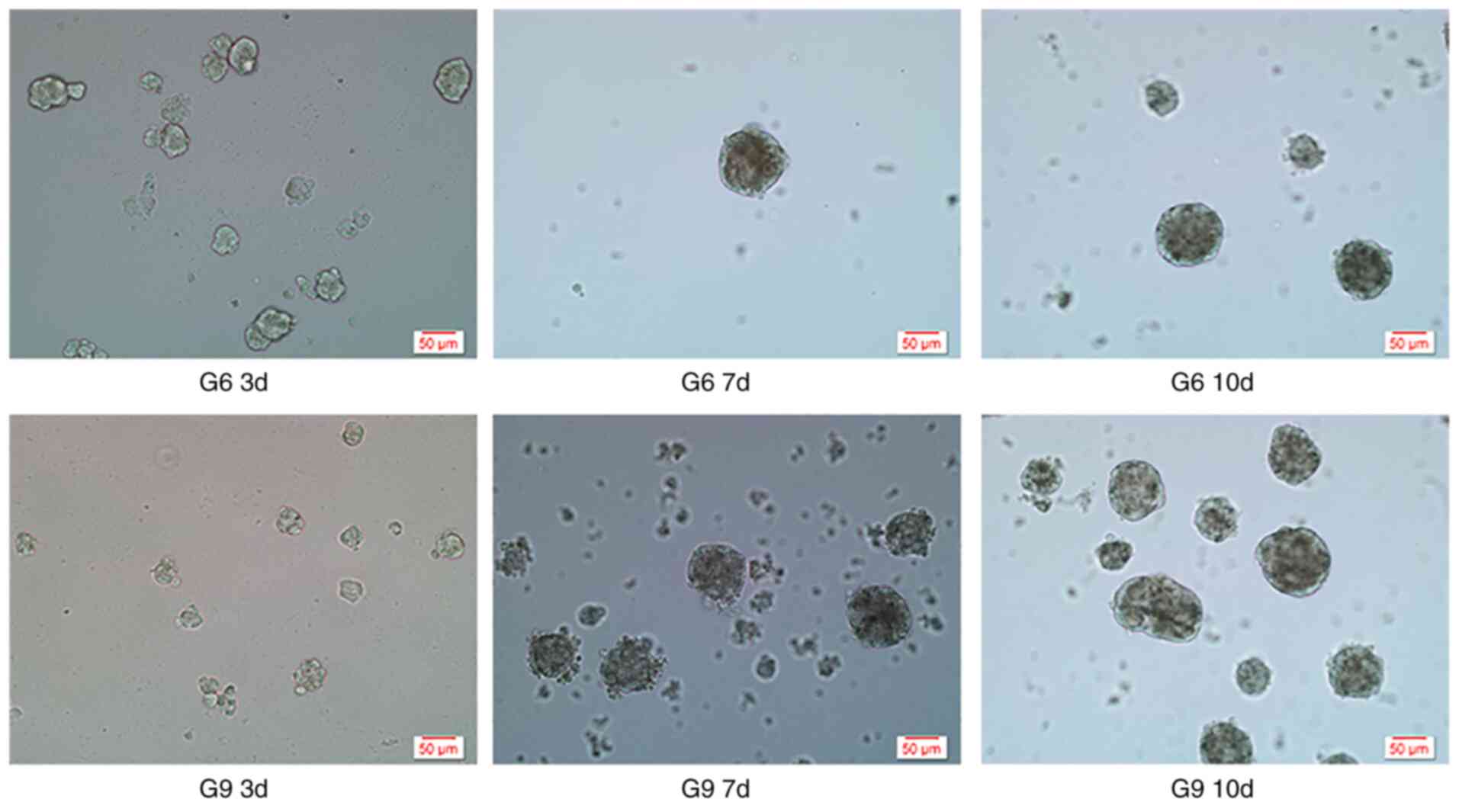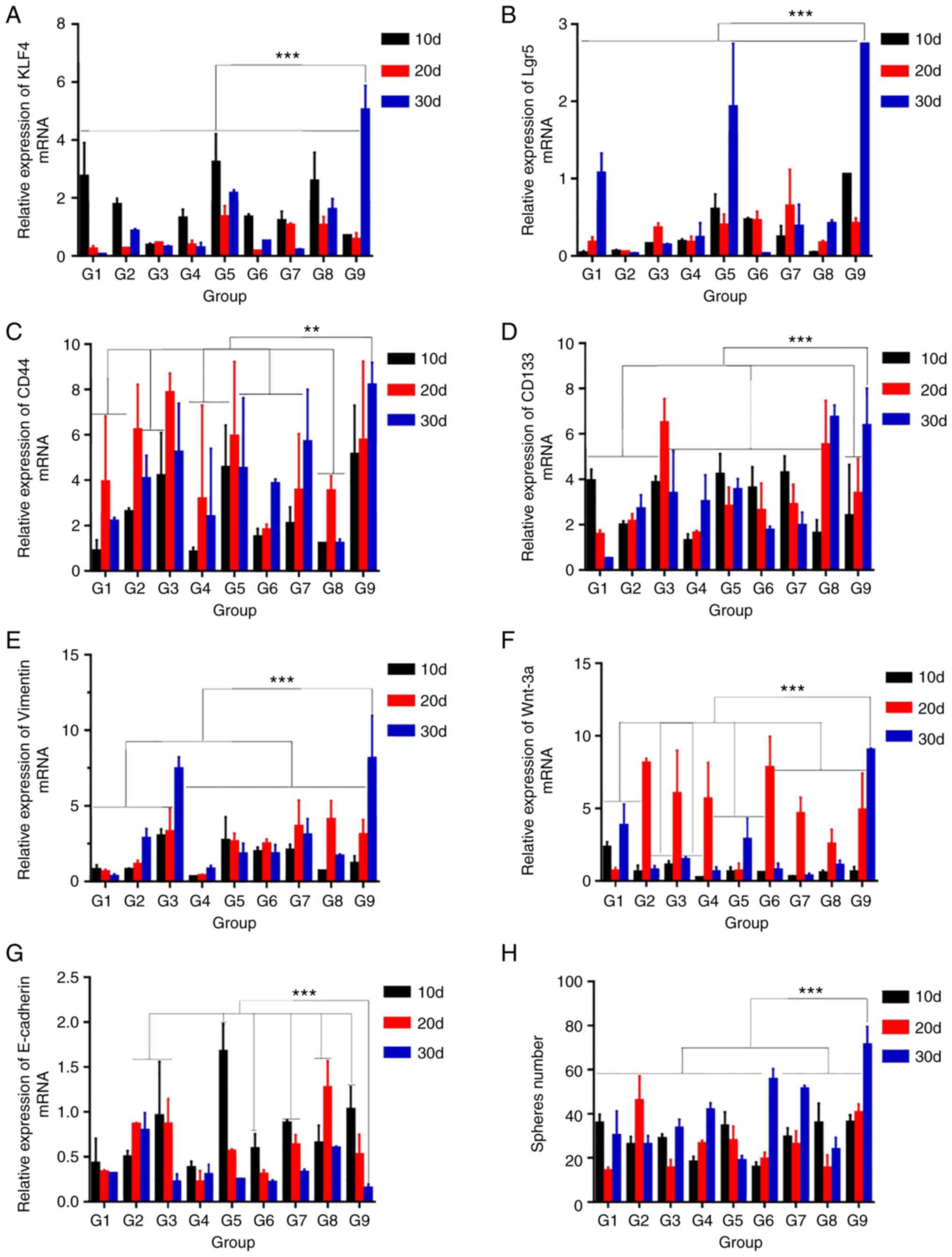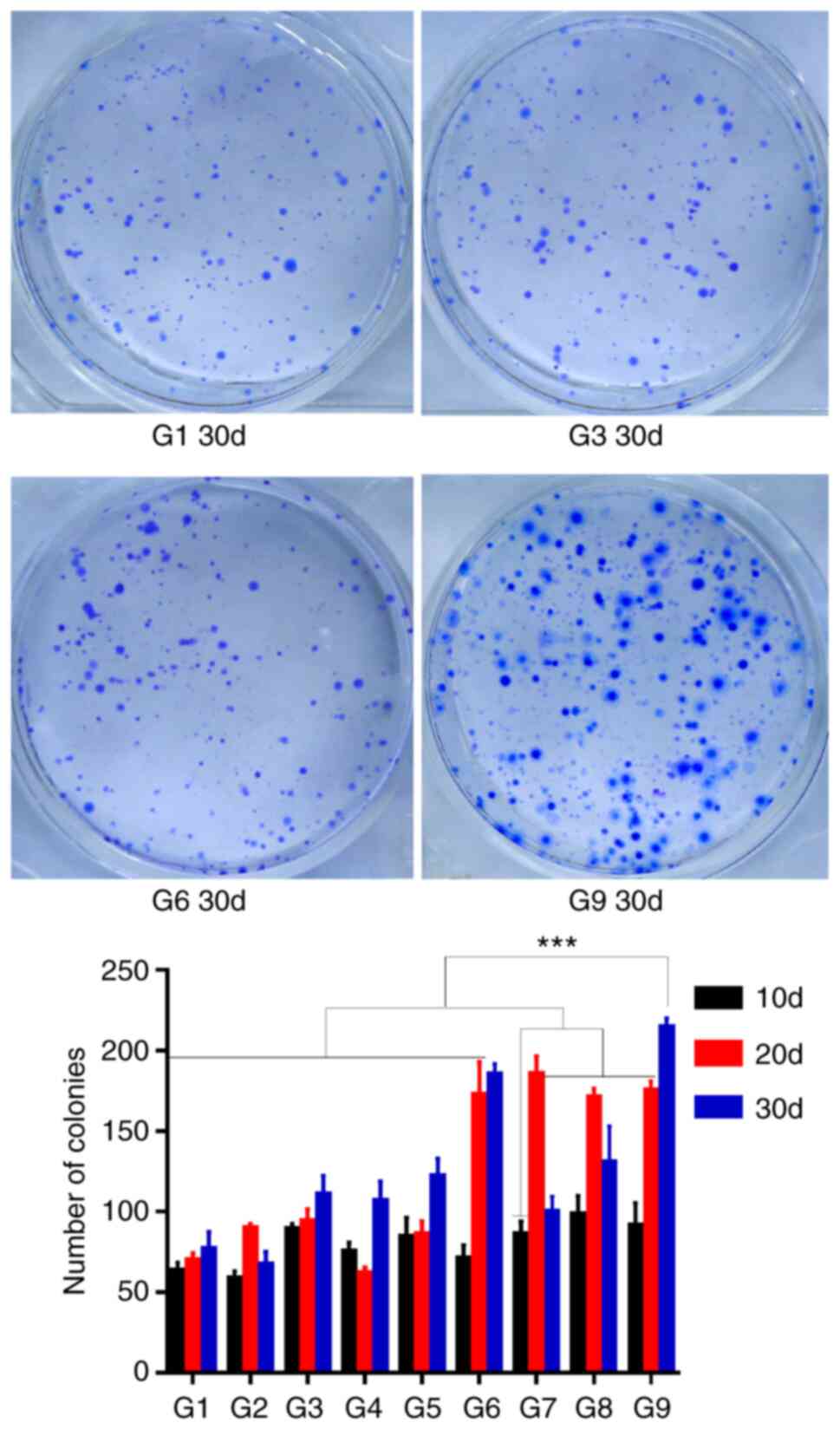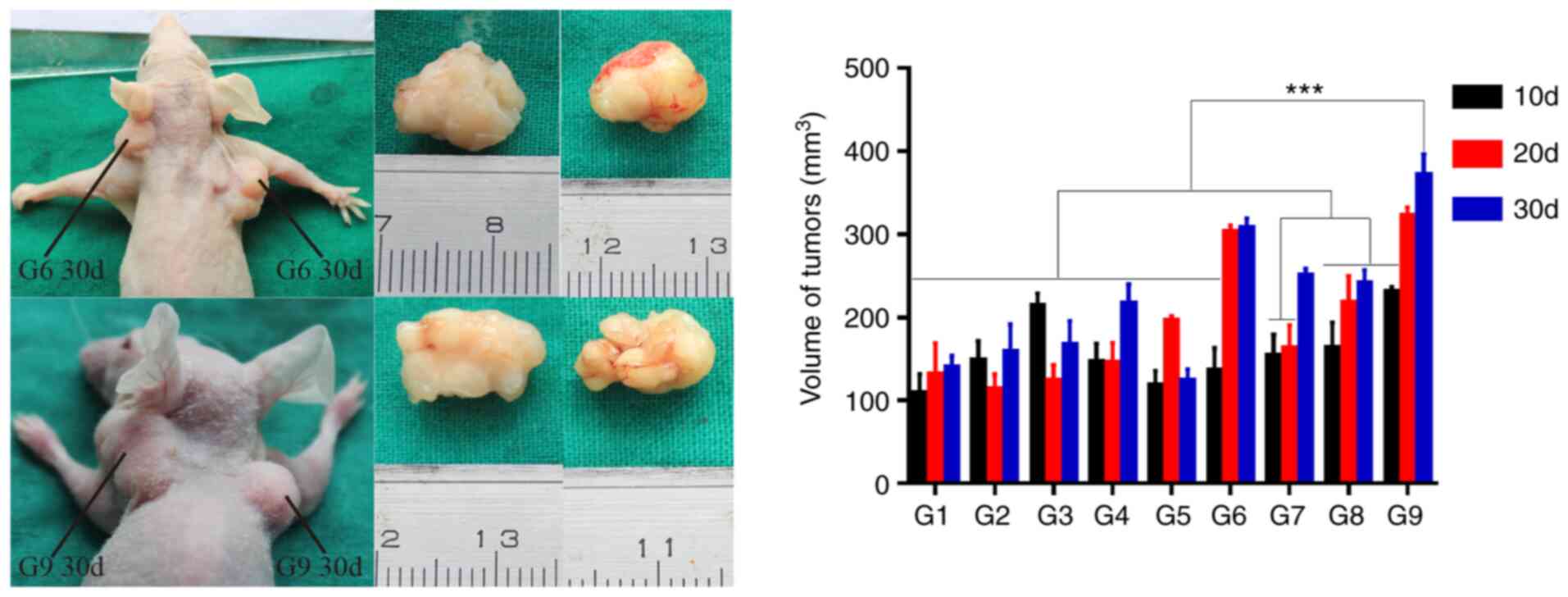|
1
|
Siegel RL, Miller KD and Jemal A: Cancer
statistics, 2020. CA Cancer J Clin. 70:7–30. 2020. View Article : Google Scholar : PubMed/NCBI
|
|
2
|
Katona BW and Weiss JM: Chemoprevention of
colorectal cancer. Gastroenterology. 158:368–388. 2020. View Article : Google Scholar : PubMed/NCBI
|
|
3
|
Jahanafrooz Z, Mosafer J, Akbari M,
Hashemzaei M, Mokhtarzadeh A and Baradaran B: Colon cancer therapy
by focusing on colon cancer stem cells and their tumor
microenvironment. J Cell Physiol. 235:4153–4166. 2020. View Article : Google Scholar : PubMed/NCBI
|
|
4
|
Agnoletto C, Corrà F, Minotti L,
Baldassari F, Crudele F, Cook WJJ, Di Leva G, d'Adamo AP, Gasparini
P and Volinia S: Heterogeneity in circulating tumor cells: The
relevance of the stem-cell subset. Cancers (Basel). 11:4832019.
View Article : Google Scholar : PubMed/NCBI
|
|
5
|
Dwivedi AR, Thakur A and Kumar V,
Skvortsova I and Kumar V: Targeting cancer stem cells pathways for
the effective treatment of cancer. Curr Drug Targets. 21:258–278.
2020. View Article : Google Scholar : PubMed/NCBI
|
|
6
|
Miyoshi N, Mizushima T, Doki Y and Mori M:
Cancer stem cells in relation to treatment. JPN J Clin Oncol.
49:232–237. 2019. View Article : Google Scholar : PubMed/NCBI
|
|
7
|
Najafi M, Mortezaee K and Ahadi R: Cancer
stem cell (a)symmetry & plasticity: Tumorigenesis and therapy
relevance. Life Sci. 231:1165202019. View Article : Google Scholar : PubMed/NCBI
|
|
8
|
Najafi M, Farhood B and Mortezaee K:
Cancer stem cells (CSCs) in cancer progression and therapy. J Cell
Physiol. 234:8381–8395. 2019. View Article : Google Scholar : PubMed/NCBI
|
|
9
|
Cammareri P, Lombardo Y, Francipane MG,
Bonventre S, Todaro M and Stassi G: Isolation and culture of colon
cancer stem cells. Methods Cell Biol. 86:311–324. 2008. View Article : Google Scholar : PubMed/NCBI
|
|
10
|
Mather JP: In vitro models. Stem Cells.
30:95–99. 2012. View
Article : Google Scholar : PubMed/NCBI
|
|
11
|
Zhu YT, Wang CY, Pang SY, Lei CY, Luo Y
and Tan WL: A modified method by differential adhesion and
serum-free culture medium for enrichment of cancer stem cells. J
Cancer Res Ther. 14 (Suppl):S421–S426. 2018. View Article : Google Scholar : PubMed/NCBI
|
|
12
|
Rai N, Singh AK, Singh SK, Gaurishankar B,
Kamble SC, Mishra P, Kotiya D, Barik S, Atri N and Gautam V: Recent
technological advancements in stem cell research for targeted
therapeutics. Drug Deliv Transl Res. 10:1147–1169. 2020. View Article : Google Scholar : PubMed/NCBI
|
|
13
|
Li W, Li Y, Cui Y, Li S, Zhu Y, Shang C,
Song G, Liu Z, Xiu Z, Cong J, et al: Anti-tumour effects of a dual
cancer-specific oncolytic adenovirus on breast cancer stem cells. J
Cell Mol Med. 25:666–676. 2021. View Article : Google Scholar : PubMed/NCBI
|
|
14
|
Ying C, Xiao B, Qin Y, Wang BR, Liu XY,
Wang RW, Fang L, Yan H, Zhou XM and Wang YG: GOLPH2-regulated
oncolytic adenovirus, GD55, exerts strong killing effect on human
prostate cancer stem-like cells in vitro and in vivo. Acta
Pharmacol Sin. 39:405–414. 2018. View Article : Google Scholar : PubMed/NCBI
|
|
15
|
Laranjo M, Carvalho MJ, Serambeque B,
Alves A, Marto CM, Silva I, Paiva A and Botelho MF: Obtaining
cancer stem cell spheres from gynecological and breast cancer
tumors. J Vis Exp. 2020. View Article : Google Scholar : PubMed/NCBI
|
|
16
|
Tian C, Lang T, Qiu J, Han K, Zhou L, Min
D, Zhang Z and Qi D: SKP1 promotes YAP-mediated colorectal cancer
stemness via suppressing RASSF1. Cancer Cell Int. 20:5792020.
View Article : Google Scholar : PubMed/NCBI
|
|
17
|
Farace C, Pisano A, Griñan-Lison C,
Solinas G, Jiménez G, Serra M, Carrillo E, Scognamillo F, Attene F,
Montella A, et al: Deregulation of cancer-stem-cell-associated
miRNAs in tissues and sera of colorectal cancer patients.
Oncotarget. 11:116–130. 2020. View Article : Google Scholar : PubMed/NCBI
|
|
18
|
Chen Y, Wang MH, Zhu JY, Xie CF, Li XT, Wu
JS, Geng SS, Han HY and Zhong CY: TAp63α targeting of Lgr5 mediates
colorectal cancer stem cell properties and sulforaphane inhibition.
Oncogenesis. 9:892020. View Article : Google Scholar : PubMed/NCBI
|
|
19
|
Chen Y, Wang X, Zhang Q, Zhu JY, Li Y, Xie
CF, Li XT, Wu JS, Geng SS, Zhong CY and Han HY:
(−)-Epigallocatechin-3-gallate inhibits colorectal cancer stem
cells by suppressing Wnt/β-catenin pathway. Nutrients. 9:5722017.
View Article : Google Scholar : PubMed/NCBI
|
|
20
|
Wen Y, Xiong X, Zaytseva YY, Napier DL,
Vallee E, Li AT, Wang C, Weiss HL, Evers BM and Gao T:
Downregulation of SREBP inhibits tumor growth and initiation by
altering cellular metabolism in colon cancer. Cell Death Dis.
9:2652018. View Article : Google Scholar : PubMed/NCBI
|
|
21
|
Cho YH, Ro EJ, Yoon JS, Mizutani T, Kang
DW, Park JC, Il Kim T, Clevers H and Choi KY: 5-FU promotes
stemness of colorectal cancer via p53-mediated WNT/β-catenin
pathway activation. Nat Commun. 11:53212020. View Article : Google Scholar : PubMed/NCBI
|
|
22
|
Guo H, Zhang B, Nairn AV, Nagy T, Moremen
KW, Buckhaults P and Pierce M: O-Linked N-acetylglucosamine
(O-GlcNAc) expression levels epigenetically regulate colon cancer
tumorigenesis by affecting the cancer stem cell compartment via
modulating expression of transcriptional factor MYBL1. J Biol Chem.
292:4123–4137. 2017. View Article : Google Scholar : PubMed/NCBI
|
|
23
|
Park JH, Kim YH, Shim S, Kim A, Jang H,
Lee SJ, Park S, Seo S, Jang WI, Lee SB and Kim MJ:
Radiation-activated PI3K/AKT pathway promotes the induction of
cancer stem-like cells via the upregulation of SOX2 in colorectal
cancer. Cells. 10:1352021. View Article : Google Scholar : PubMed/NCBI
|
|
24
|
Guo P, Wang J, Gao W, Liu X, Wu S, Wan B,
Xu L and Li Y: Salvianolic acid B reverses multidrug resistance in
nude mice bearing human colon cancer stem cells. Mol Med Rep.
18:1323–1334. 2018.PubMed/NCBI
|
|
25
|
Wang L, Huang X, Zheng X, Wang X, Li S,
Zhang L, Yang Z and Xia Z: Enrichment of prostate cancer stem-like
cells from human prostate cancer cell lines by culture in
serum-free medium and chemoradiotherapy. Int J Biol Sci. 9:472–479.
2013. View Article : Google Scholar : PubMed/NCBI
|
|
26
|
Sanches JGP, Song B, Zhang Q, Cui X,
Yabasin IB, Ntim M, Li X, He J, Zhang Y, Mao J, et al: The role of
KDM2B and EZH2 in regulating the stemness in colorectal cancer
through the PI3K/AKT pathway. Front Oncol. 11:6372982021.
View Article : Google Scholar : PubMed/NCBI
|
|
27
|
Mirzaei H, Salehi H, Sahebkar A, Avan A,
Jaafari MR, Namdar A, Rezaei A and Mirzaei HR: Deciphering
biological characteristics of tumorigenic subpopulations in human
colorectal cancer reveals cellular plasticity. J Res Med Sci.
21:642016. View Article : Google Scholar : PubMed/NCBI
|
|
28
|
Chen M, Sharma A, Lin Y, Wu Y, He Q, Gu Y,
Xu ZP, Monteiro M and Gu W: Insluin and epithelial growth factor
(EGF) promote programmed death ligand 1(PD-L1) production and
transport in colon cancer stem cells. BMC Cancer. 19:1532019.
View Article : Google Scholar : PubMed/NCBI
|
|
29
|
Liu QQ, Li CM, Fu LN, Wang HL, Tan J, Wang
YQ, Sun DF, Gao QY, Chen YX and Fang JY: Enterotoxigenic
bacteroides fragilis induces the stemness in colorectal cancer via
upregulating histone demethylase JMJD2B. Gut Microbes.
12:17889002020. View Article : Google Scholar : PubMed/NCBI
|
|
30
|
Shiraiwa K, Matsuse M, Nakazawa Y, Ogi T,
Suzuki K, Saenko V, Xu S, Umezawa K, Yamashita S, Tsukamoto K and
Mitsutake N: JAK/STAT3 and NF-κB signaling pathways regulate cancer
stem-cell properties in anaplastic thyroid cancer cells. Thyroid.
29:674–682. 2019. View Article : Google Scholar : PubMed/NCBI
|
|
31
|
Leng Z, Tao K, Xia Q, Tan J, Yue Z, Chen
J, Xi H, Li J and Zheng H: Krüppel-like factor 4 acts as an
oncogene in colon cancer stem cell-enriched spheroid cells. PLoS
One. 8:e560822013. View Article : Google Scholar : PubMed/NCBI
|
|
32
|
Munro MJ, Wickremesekera SK, Peng L, Tan
ST and Itinteang T: Cancer stem cells in colorectal cancer: A
review. J Clin Pathol. 71:110–116. 2018. View Article : Google Scholar : PubMed/NCBI
|
|
33
|
Kozovska Z, Gabrisova V and Kucerova L:
Colon cancer: cancer stem cells markers, drug resistance and
treatment. Biomed Pharmacother. 68:911–916. 2014. View Article : Google Scholar : PubMed/NCBI
|
|
34
|
Otte J, Dizdar L, Behrens B, Goering W,
Knoefel WT, Wruck W, Stoecklein NH and Adjaye J: FGF signalling in
the self-renewal of colon cancer organoids. Sci Rep. 9:173652019.
View Article : Google Scholar : PubMed/NCBI
|
|
35
|
Castagnoli L, De Santis F, Volpari T,
Vernieri C, Tagliabue E, Di Nicola M and Pupa SM: Cancer stem
cells: Devil or savior-looking behind the scenes of immunotherapy
failure. Cells. 9:5552020. View Article : Google Scholar : PubMed/NCBI
|
|
36
|
Annett S and Robson T: Targeting cancer
stem cells in the clinic: Current status and perspectives.
Pharmacol Ther. 187:13–30. 2018. View Article : Google Scholar : PubMed/NCBI
|
|
37
|
Gupta R, Bhatt LK, Johnston TP and
Prabhavalkar KS: Colon cancer stem cells: Potential target for the
treatment of colorectal cancer. Cancer Biol Ther. 20:1068–1082.
2019. View Article : Google Scholar : PubMed/NCBI
|
|
38
|
Garza Treviño EN, González PD, Valencia
Salgado CI and Martinez Garza A: Effects of pericytes and colon
cancer stem cells in the tumor microenvironment. Cancer Cell Int.
19:1732019. View Article : Google Scholar : PubMed/NCBI
|
|
39
|
Fong CY, Peh GS, Gauthaman K and Bongso A:
Separation of SSEA-4 and TRA-1-60 labelled undifferentiated human
embryonic stem cells from a heterogeneous cell population using
magnetic-activated cell sorting (MACS) and fluorescence-activated
cell sorting (FACS). Stem Cell Rev Rep. 5:72–80. 2009. View Article : Google Scholar : PubMed/NCBI
|
|
40
|
Tsunekuni K, Konno M, Haraguchi N, Koseki
J, Asai A, Matsuoka K, Kobunai T, Takechi T, Doki Y, Mori M and
Ishii H: CD44/CD133-positive colorectal cancer stem cells are
sensitive to trifluridine exposure. Sci Rep. 9:148612019.
View Article : Google Scholar : PubMed/NCBI
|
|
41
|
Toledo-Guzmán ME, Hernández MI,
Gómez-Gallegos ÁA and Ortiz-Sánchez E: ALDH as a stem cell marker
in solid tumors. Curr Stem Cell Res Ther. 14:375–388. 2019.
View Article : Google Scholar : PubMed/NCBI
|
|
42
|
Fumagalli A, Oost KC, Kester L, Morgner J,
Bornes L, Bruens L, Spaargaren L, Azkanaz M, Schelfhorst T,
Beerling E, et al: Plasticity of Lgr5-negative cancer cells drives
metastasis in colorectal cancer. Cell Stem Cell. 26:569–578.e7.
2020. View Article : Google Scholar : PubMed/NCBI
|
|
43
|
Leng Z, Xia Q, Chen J, Li Y, Xu J, Zhao E,
Zheng H, Ai W and Dong J: Lgr5+CD44+EpCAM+ strictly defines cancer
stem cells in human colorectal cancer. Cell Physiol Biochem.
46:860–872. 2018. View Article : Google Scholar : PubMed/NCBI
|
|
44
|
Olejniczak A, Szaryńska M and Kmieć Z: In
vitro characterization of spheres derived from colorectal cancer
cell lines. Int J Oncol. 52:599–612. 2018.PubMed/NCBI
|
|
45
|
Olejniczak-Kęder A, Szaryńska M, Wrońska
A, Siedlecka-Kroplewska K and Kmieć Z: Effects of 5-FU and
anti-EGFR antibody in combination with ASA on the spherical culture
system of HCT116 and HT29 colorectal cancer cell lines. Int J
Oncol. 55:223–242. 2019.PubMed/NCBI
|
|
46
|
Prasetyanti PR and Medema JP: Intra-tumor
heterogeneity from a cancer stem cell perspective. Mol Cancer.
16:412017. View Article : Google Scholar : PubMed/NCBI
|
|
47
|
Kuşoğlu A and Biray Avcı Ç: Cancer stem
cells: A brief review of the current status. Gene. 681:80–85. 2019.
View Article : Google Scholar : PubMed/NCBI
|
|
48
|
Kim B, Seo Y, Kwon JH, Shin Y, Kim S, Park
SJ, Park JJ, Cheon JH, Kim WH and Il Kim T: IL-6 and IL-8, secreted
by myofibroblasts in the tumor microenvironment, activate HES1 to
expand the cancer stem cell population in early colorectal tumor.
Mol Carcinog. 60:188–200. 2021. View Article : Google Scholar : PubMed/NCBI
|
|
49
|
Lenos KJ, Miedema DM, Lodestijn SC, Nijman
LE, van den Bosch T, Romero Ros X, Lourenço FC, Lecca MC, van der
Heijden M, van Neerven SM, et al: Stem cell functionality is
microenvironmentally defined during tumour expansion and therapy
response in colon cancer. Nat Cell Biol. 20:1193–1202. 2018.
View Article : Google Scholar : PubMed/NCBI
|
|
50
|
Gur-Cohen S, Yang H, Baksh SC, Miao Y,
Levorse J, Kataru RP, Liu X, de la Cruz-Racelis J, Mehrara BJ and
Fuchs E: Stem cell-driven lymphatic remodeling coordinates tissue
regeneration. Science. 366:1218–1225. 2019. View Article : Google Scholar : PubMed/NCBI
|
|
51
|
van der Heijden M and Vermeulen L: Stem
cells in homeostasis and cancer of the gut. Mol Cancer. 18:662019.
View Article : Google Scholar : PubMed/NCBI
|
|
52
|
Ahmed N, Escalona R, Leung D, Chan E and
Kannourakis G: Tumour microenvironment and metabolic plasticity in
cancer and cancer stem cells: Perspectives on metabolic and immune
regulatory signatures in chemoresistant ovarian cancer stem cells.
Semin Cancer Biol. 53:265–281. 2018. View Article : Google Scholar : PubMed/NCBI
|
|
53
|
Zhang X, Bandyopadhyay S, Araujo LP, Tong
K, Flores J, Laubitz D, Zhao Y, Yap G, Wang J, Zou Q, et al:
Elevating EGFR-MAPK program by a nonconventional Cdc42 enhances
intestinal epithelial survival and regeneration. JCI Insight.
5:e1359232020. View Article : Google Scholar : PubMed/NCBI
|
|
54
|
Mossahebi-Mohammadi M, Quan M, Zhang JS
and Li X: FGF signaling pathway: A key regulator of stem cell
pluripotency. Front Cell Dev Biol. 8:792020. View Article : Google Scholar : PubMed/NCBI
|
|
55
|
Clara JA, Monge C, Yang Y and Takebe N:
Targeting signalling pathways and the immune microenvironment of
cancer stem cells-a clinical update. Nat Rev Clin Oncol.
17:204–232. 2020. View Article : Google Scholar : PubMed/NCBI
|
|
56
|
Kahn M: Wnt signaling in stem cells and
cancer stem cells: A tale of two coactivators. Prog Mol Biol Transl
Sci. 153:209–244. 2018. View Article : Google Scholar : PubMed/NCBI
|
|
57
|
Najafi M, Mortezaee K and Majidpoor J:
Cancer stem cell (CSC) resistance drivers. Life Sci.
234:1167812019. View Article : Google Scholar : PubMed/NCBI
|
|
58
|
Saltanatpour Z, Johari B, Alizadeh A,
Lotfinia M, Majidzadeh-A K, Nikbin B and Kadivar M: Enrichment of
cancer stem-like cells by the induction of epithelial-mesenchymal
transition using lentiviral vector carrying E-cadherin shRNA in
HT29 cell line. J Cell Physiol. 234:22935–22946. 2019. View Article : Google Scholar : PubMed/NCBI
|













